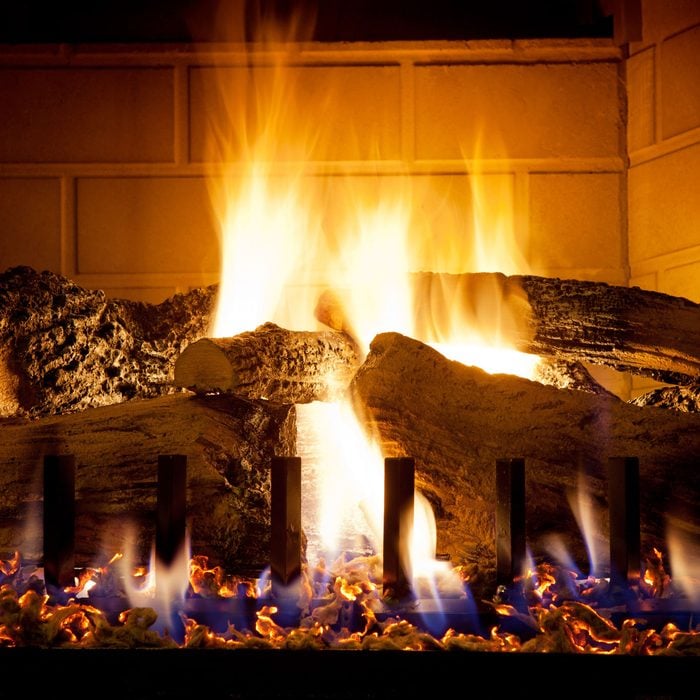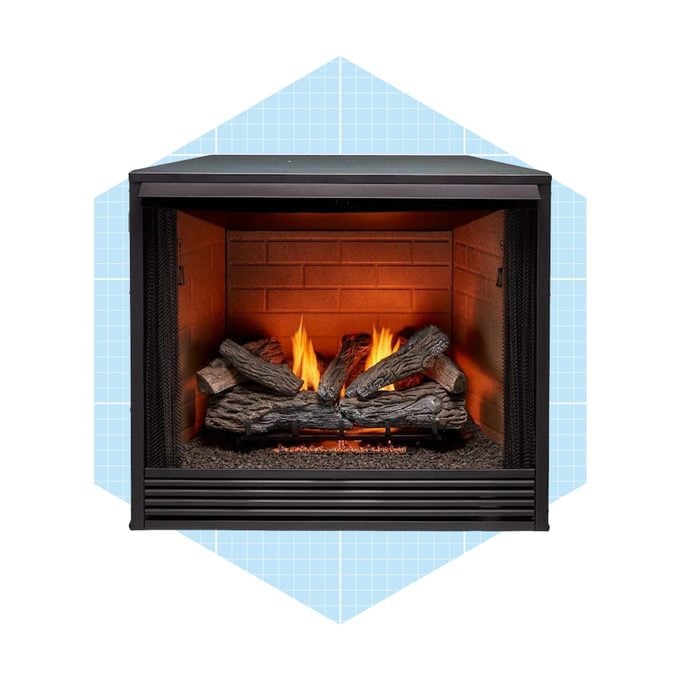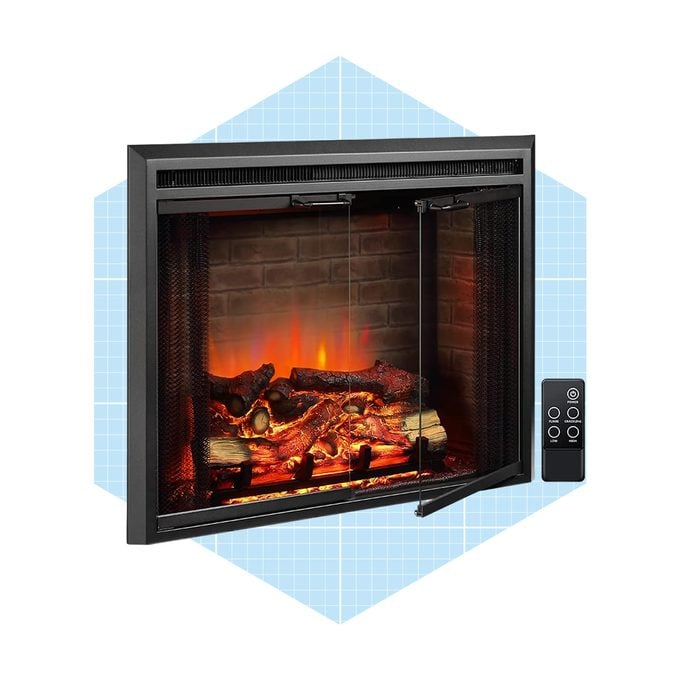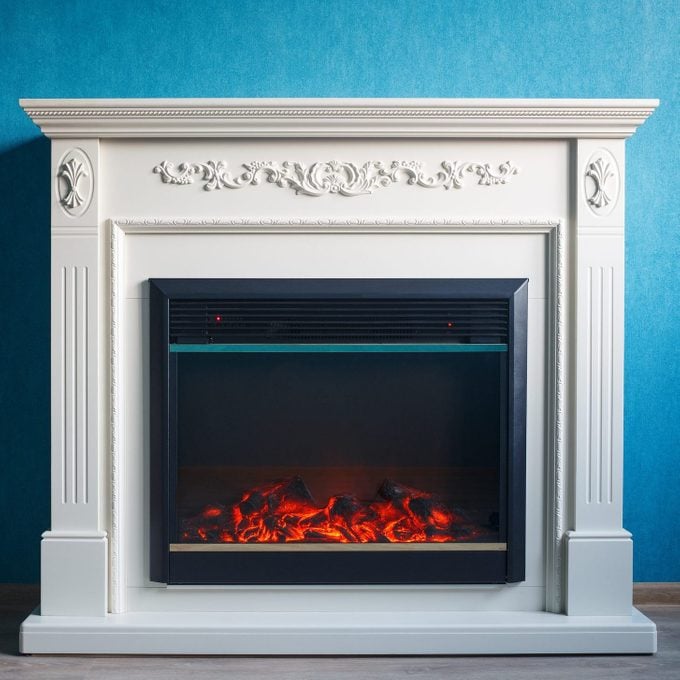Gas vs. Electric Fireplaces: Here’s How to Choose One for Your Home
Updated: Nov. 29, 2023

Choosing between gas vs. electric fireplaces can be tricky. We go through the pros and cons of each to help you decide which is better for your home.
Our editors and experts handpick every product we feature. We may earn a commission from your purchases.
Humans respond to fire on a primal level. Maybe it’s a throwback to when our ancestors huddled together, holding back the darkness with crackling flames—or maybe we just love the cozy warmth of a fire in our homes. Either way, it’s no surprise that many homeowners opt to install a fireplace. And in recent years, increased efficiency and lower prices have made fireplace installations a popular addition to American living spaces.
While it’s possible to add a new wood-burning fireplace to an existing home, the more affordable options are usually gas or electric. Here’s what you need to know before you buy a gas vs. electric fireplace, and how to decide which model is best for you. We’ve also included some of our favorite gas and electric fireplace picks to make your shopping experience stress free.
On This Page
What’s the difference between gas fireplace and electric fireplaces?
In short, gas fireplaces generate heat with natural flame while electric fireplaces engage a heating element (much like a space heater) while creating the illusion of flames with flickering lights or video. However, there are other major differences to consider when it comes to gas and electric fireplaces, like installation, operating costs, maintenance and safety.
Installation
Gas fireplaces generally cost more to purchase and to install than their electric counterparts. If you don’t have a natural gas line, you’ll need to add one (which may not be an option where you live) or hook up a propane supply. Electric fireplaces require standard electrical outlets, but you may need to run a new line or, for larger units, a dedicated circuit. Whether it takes a 110- or 220-volt outlet depends on the fireplace.
Gas fireplaces also have more requirements on their placement inside the home. Vented gas fireplaces must allow for outside exhaust, usually against an exterior wall or inserted into an existing masonry fireplace. Ventless gas fireplaces aren’t legal in all states, so check your local codes before purchasing. Electric fireplaces don’t need to be vented because they don’t produce carbon monoxide.
Maintenance
Modern gas and electric fireplaces need little maintenance. You may want to clean the glass front from time to time with a cleaner suggested by the manufacturer, especially on electric models with liquid crystal display (LCD) screens. With a vented gas fireplace, clean the flue once a year or so.
Safety
Both types of fireplaces produce heat and should be viewed as potential fire hazards. But it only takes a little caution to make your fireplace safe and secure.
Be sure that your fireplace is properly installed, and use common sense. Don’t store flammable items next to the fireplace, and watch children and pets to make sure they don’t stray too close. Gas fireplaces in particular can be hot to the touch. They also produce carbon monoxide (CO). Ventless fireplaces burn especially clean, allowing them to be vented indoors. If your fireplace vents through a first-floor wall, make sure you don’t store items outside that obstruct the airflow around the vent.
And, of course, be sure to have a CO detector in your home.
How to Choose Between Gas vs. Electric Fireplaces
Gas and electric fireplaces are great choices for adding a little cozy warmth to your home. But when it comes time to pick one, consider these points.
Choose a gas fireplace if you:
- Love the look of natural flame
- Have high electrical costs
- Already have a gas line
- Hope to heat a larger space
- Aren’t concerned about pets or kids getting close
Choose an electric fireplace if you:
- Don’t have a gas line
- Don’t care about having a natural flame
- Like it cozy, but aren’t interested in heating a large space
- Don’t have high electrical costs
- Want to keep the purchase price as low as possible
- Worry about pets or kids getting close
- Would like a fully DIY install option
- Want the safest possible option
Our Favorite Gas Fireplace Insert
Meet the best gas option, a modern gas fireplace insert that turns on and off instantly, doesn’t require chopping wood and is easy to keep clean.
ProCom Universal Ventless Firebox

ProCom is known for its budget-friendly gas fireplace options. This impressive 36-inch wall insert doesn’t require any electricity to add a vent-free gas fireplace to your living space.
The brand’s fireboxes are approved for zero-clearance installation, which means that you can recess it into your wall or pair it with a cabinet mantel for a custom unit (as long as there is a gas line). Plus, you can use it with any ventless gas log set, and it features a decorative brick liner for a classic finish.
Our Favorite Electric Fireplace Insert
Decided you want an electric fireplace? The best option is safe, non-toxic and still provides warmth.
PuraFlame Klaus Electric Fireplace Insert

The PuraFlame electric fireplace insert is our top pick for its value pricing, range of size options, easy installation, lifelike appearance and adjustable thermostat. With a flat bottom, this gas fireplace insert can be placed into the wall or sit on the floor directly. It has light-emitting diode (LED) energy-saving technology and three flame settings with different levels of intensity and brightness. Plus, it can be used with or without heat, so you can use your fireplace year round, even during warmer months.
We like the way this one looks, too. It has lifelike resin logs just above the ember bed to mimic what a wood-burning fireplace actually looks like. With a traditional design, interior brick walls, a glass door and a mesh screen, this insert also has all of the major components that make it look realistic without the fuss of real flames.
How Efficient are Gas vs. Electric Fireplaces
Generally speaking, electric fireplaces are more efficient than gas fireplaces. Electric fireplaces convert all of their energy into heat while gas fireplaces convert about 70% to 90% of their energy into heat. And while electric fireplaces convert energy into warmth more efficiently, it’s possible that they may take longer than gas fireplaces to generate the same amount of warmth.
That said, when it comes to cost, different factors like local utility costs, venting and how long you run your fireplace will determine whether a gas vs. electric fireplace will be more economical for your lifestyle. However, electric fireplaces are typically cheaper to purchase and install upfront.
Why You Should Trust Us
Dan Stout is a former residential remodeler, commercial site supervisor and maintenance manager. He’s worked on nearly all aspects of building and DIY, including project planning and permitting, plumbing, basic electric, drywall, carpentry, tiling, painting and more.
Stout has covered everything from how to upgrade your furnace to power tools to woodworking and backyard fire pits. His expertise in building, project planning and electric help him write knowledgeable content about fireplaces and other home improvement projects.
